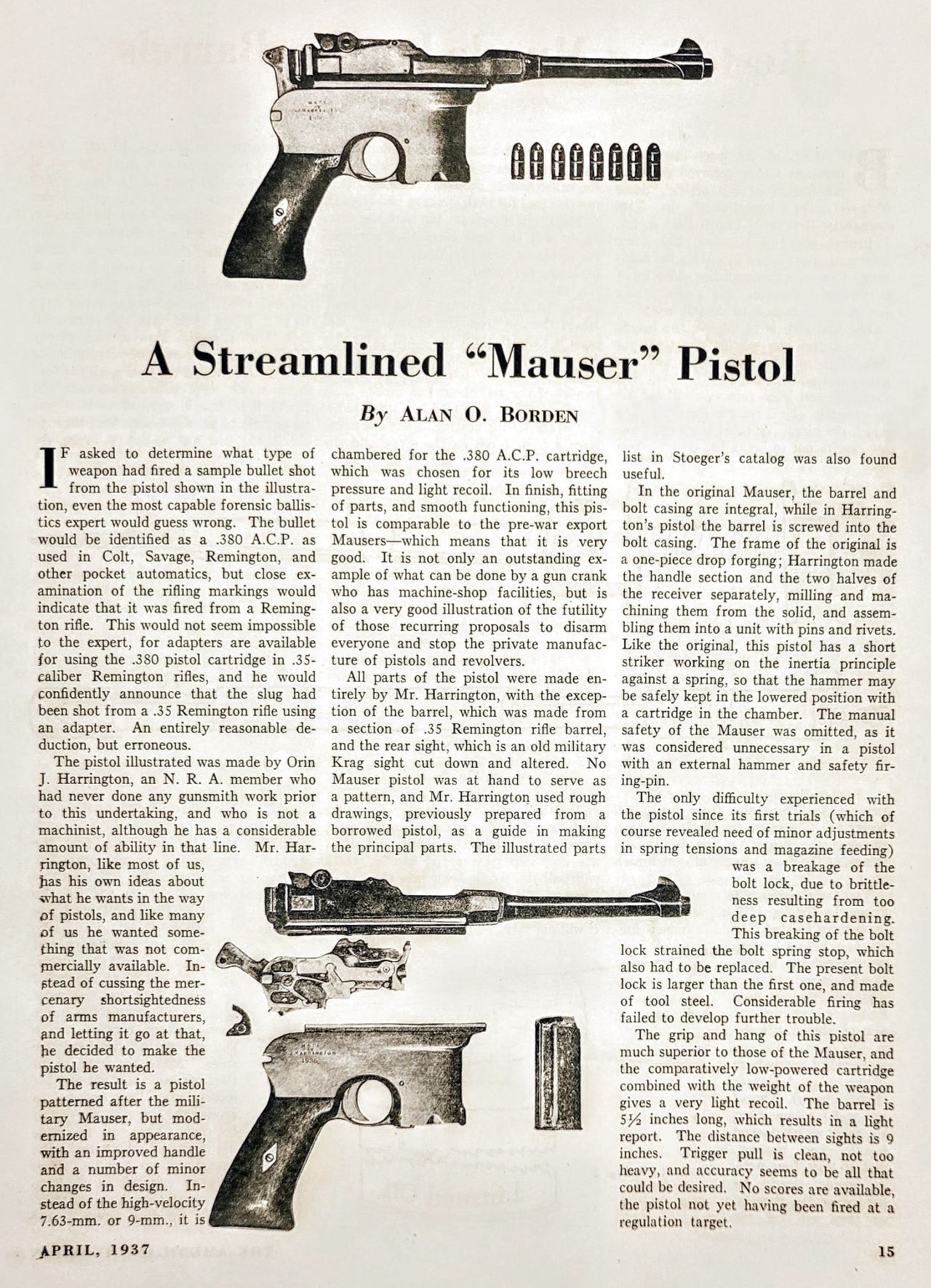A Streamlined "Mauser" Pistol (The American Rifleman, April 1937)
Jump to navigation
Jump to search

An archival copy of the article "A Streamlined 'Mauser' Pistol" by Alan O. Borden, appearing in the April 1937 issue of the NRA's "The American Rifleman" magazine. It involves an interesting discussion about a custom Mauser-style pistol, chambered in .380 ACP by one Orin J. Harrington, a man who had no prior gunsmithing experience, but who wanted something unique that wasn't commercially available. Includes scanned image and full text of the article below.
Article Scan

A scan of Alan O. Borden's article "A Streamlined 'Mauser' Pistol" from the April 1937 issue of "The American Rifleman". It entails an interesting custom Mauser pistol chambered in .380 ACP by one Orin J. Harrington.
Article Text
A Streamlined "Mauser" Pistol
By Alan O. Borden
If asked to determine what type of weapon had fired a sample bullet shot from the pistol shown in the illustration, even the most capable forensic ballistics expert would guess wrong. The bullet would be identified as a .380 A.C.P. as used in Colt, Savage, Remington, and other pocket automatics, but close ex- amination of the rifling markings would indicate that it was fired from a Remington rifle. This would not seem impossible to the expert, for adapters are available for using the .380 pistol cartridge in .35-caliber Remington rifles, and he would confidently announce that the slug had been shot from a .35 Remington rifle using an adapter. An entirely reasonable deduction, but erroneous.
The pistol illustrated was made by Orin J. Harrington, an N. R. A. member who had never done any gunsmith work prior to this undertaking, and who is not a machinist, although he has a considerable amount of ability in that line. Mr. Harrington, like most of us, has his own ideas about what he wants in the way of pistols, and like many of us he wanted some thing that was not commercially available. In stead of cussing the mercenary shortsightedness of arms manufacturers, and letting it go at that, he decided to make the pistol he wanted.
The result is a pistol patterned after the military Mauser, but modernized in appearance, with an improved handle and a number of minor changes in design. In stead of the high-velocity 7.63-mm. or 9-mm., it is chambered for the .380 A.C.P. cartridge, which was chosen for its low breech pressure and light recoil. In finish, fitting of parts, and smooth functioning, this pistol is comparable to the pre-war export Mausers which means that it is very good. It is not only an outstanding ex- ample of what can be done by a gun crank who has machine-shop facilities, but is also a very good illustration of the futility of those recurring proposals to disarm everyone and stop the private manufacture of pistols and revolvers.
All parts of the pistol were made entirely by Mr. Harrington, with the exception of the barrel, which was made from a section of .35 Remington rifle barrel, and the rear sight, which is an old military Krag sight cut down and altered. No Mauser pistol was at hand to serve as a pattern, and Mr. Harrington used rough drawings, previously prepared from a borrowed pistol, as a guide in making the principal parts. The illustrated parts list in Stoeger's catalog was also found useful. In the original Mauser, the barrel and bolt casing are integral, while in Harrington's pistol the barrel is screwed into the bolt casing. The frame of the original is a one-piece drop forging; Harrington made the handle section and the two halves of the receiver separately, milling and machining them from the solid, and assembling them into a unit with pins and rivets. Like the original, this pistol has a short striker working on the inertia principle against a spring, so that the hammer may be safely kept in the lowered position with a cartridge in the chamber. The manual safety of the Mauser was omitted, as it was considered unnecessary in a pistol with an external hammer and safety firing pin.
The only difficulty experienced with the pistol since its first trials (which of course revealed need of minor adjustments in spring tensions and magazine feeding) was a breakage of the bolt lock, due to brittleness resulting from too deep casehardening. This breaking of the bolt lock strained the bolt spring stop, which also had to be replaced. The present bolt lock is larger than the first one, and made of tool steel. Considerable firing has failed to develop further trouble. The grip and hang of this pistol are much superior to those of the Mauser, and the comparatively low-powered cartridge combined with the weight of the weapon gives a very light recoil. The barrel is 5½ inches long, which results in a light report. The distance between sights is 9 inches. Trigger pull is clean, not too heavy, and accuracy seems to be all that could be desired. No scores are available, the pistol not yet having been fired at a regulation target.